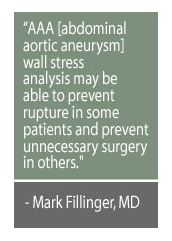For Release: April 02, 2003
Contact: DMS Communications (603) 650-1492
Print Version
Dartmouth Researchers Find New Imaging Method May Lower Risks for Abdominal Aortic Aneurysms

HANOVER, NH - A study by researchers at Dartmouth-Hitchcock Medical Center (DHMC), Dartmouth Medical School (DMS) and Dartmouth Thayer School of Engineering could have implications for choosing which patients with abdominal aortic aneurysms should have surgery and which ones should simply have follow-up with noninvasive studies. The results were published in the April issue of the Journal of Vascular Surgery.
Dr. Mark Fillinger, associate professor of surgery at DMS, and colleagues describe a new noninvasive method for evaluating abdominal aortic aneurysms (AAA). They found that the method - examining aneurysm wall stress - predicts AAA rupture risk better than aneurysm diameter, which has been used to predict rupture risk for over 40 years.

In the multidisciplinary study, sponsored by the National Heart Lung and Blood Institute and conducted at Dartmouth-Hitchcock Medical Center, over 100 patients who had computed tomography (CT) scans during the course of routine care had AAA "wall stress analysis." The CT scan is processed through a series of computer programs, including an engineering process called finite element analysis. Finite element analysis breaks the structure into thousands of tiny elements so a computer can calculate the wall stress using the three-dimensional shape of the AAA (from the CT scan), the patient's blood pressure, and the tissue properties of typical AAAs. The result is a computer-generated "stress map" that displays the aneurysm wall stress (the force trying to pull the aneurysm apart and cause rupture).
The study patients were generally under observation for their aneurysm for one of three reasons: 1) because the aneurysm was felt to be too small to repair, 2) because the risks of repair were felt to be too high compared to the risk of aneurysm rupture, or 3) because the patient decided not to have aneurysm repair. The outcomes of observation were then compared based on the standard method of determining rupture risk (maximum AAA diameter) versus the maximum stress within the aneurysm wall. The researchers had previously determined that wall stress was high at the time of rupture, but this was the first large study of AAA wall stress in patients under extended periods of observation.
Researchers found that the new technique (aneurysm wall stress analysis) predicted the risk of rupture better than maximum AAA diameter, with a 25-fold increase in rupture risk for patients with high AAA wall stress, and only 9-fold higher rupture risk for patients with large diameter (over 5.5 cm). The location of rupture (when known) was also consistent with the location of maximum stress predicted by the computerized stress map. Interestingly, some patients with small aneurysms had high wall stress (high risk of rupture) and some patients with large aneurysms had low wall stress (low risk of rupture).
"This study has several important aspects. Some patients with small aneurysms (based on diameter) have an unexpectedly high risk of rupture and should have surgery earlier than is typically recommended" says Fillinger. "Other patients with larger aneurysms, but high risks for surgery, may delay surgery and have observation with noninvasive studies if we can reliably predict that they have a low rupture risk. Another impact of this study may be that blood pressure control in aneurysm patients will be examined with more scrutiny, since blood pressure plays a key role in AAA wall stress. We have made great strides with minimally invasive surgery for aortic aneurysms, but not everyone is a candidate for these techniques. AAA wall stress analysis may be able to prevent rupture in some patients and prevent unnecessary surgery in others."
The risk of rupture relative to AAA diameter and female gender (known risks for aneurysm rupture) were consistent with recent large clinical trials in the US and UK. In those studies, patients with AAAs under close observation with ultrasound every 6 months still had a small risk of rupture, with higher risks for women. "The consistency of our current study with the US and UK small aneurysm trials is encouraging," Fillinger continued. "In future work, we hope to determine why females are at greater risk for rupture than males. We would like to improve the aneurysm tissue model, and hope to start a larger multicenter study within the next year."
An estimated 2 million people in the US have abdominal aortic aneurysms, and AAA rupture is the thirteenth leading cause of death in men. Many people are unaware they have aortic aneurysms because they cause no symptoms prior to rupture. The increasing incidence of AAA nationwide has led to more attention regarding screening for AAA.
For more information, contact Tamsin Stubbs at (603) 653-1997